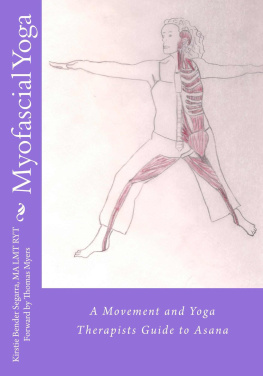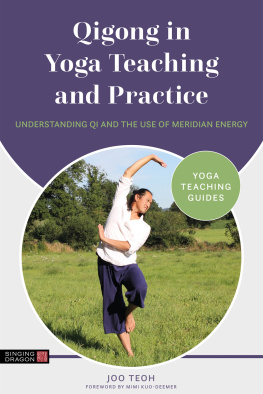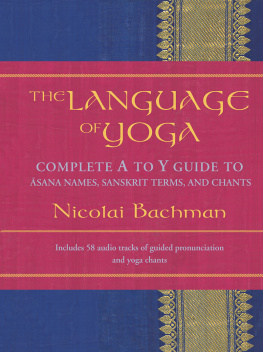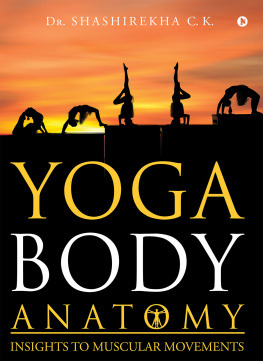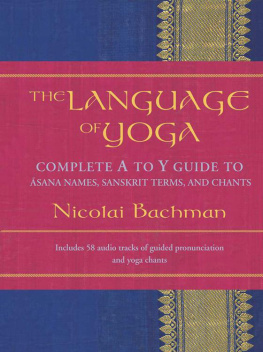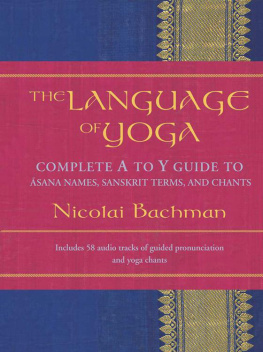Myofascial Yoga
A movement and Yoga Therapists guide to ASANA |
Kirstie Bender Segarra, PhD LMT ERYT |
Myofascial Yoga
A movement and Yoga Therapists guide to ASANA
Copyright 2013 Kirstie Bender Segarra
All rights reserved.
No part of this publication may be reproduced or transmitted in any form or by any means, electronic or mechanical, including photocopying, recording, or any information storage and retrieval system, without permission in writing from the author. Permission may be sought by contacting balinesetraditionalmassage.com.
First Edition 2013
ISBN: 10-1484838785
ISBN-13: 978-1484838785
The author/publisher has made every effort to trace holders of copyright in original material and to seek permission for its use in Myofascial Yoga: A movement and yoga therapists guide to asana. Should this have proved impossible, then copyright holders are asked to contact the publisher so that suitable acknowledgement can be made at the first opportunity.
In dedication with loving memory to Mary Owen Dean Scott, Ph.D.
a.k.a. Tutu.
Table of Contents
Myofascial Yoga
A movement and Yoga Therapists guide to ASANA
FORWARD
INTRODUCTION
CHAPTER ONE: WHAT IS MYOFASCIAL YOGA?
CHAPTER TWO: Superficial BACK LINE and Superficial Front Line
CHAPTER Three: Lateral Line, Our internal fishiness
CHAPTER Four: spiral Line or Mbius strip
CHAPTER Five: deep front line, our core
CHAPTER SIX: The Arm lines and Functional Line
CHAPTER Seven: Alignment, Touch and Body Reading
CHAPTER eight: eastern MEDICINE
CHAPTER nine: Sequencing your myofascial yoga class
Conclusion
Works Cited
Contributors and Models
FORWARD
Given how sedentary and routinized our post-industrial society has become, we can salute and encourage all forms of movement training, because each has a value to different people at different times in their lives. Yoga is of course one of the oldest attempts, along with martial arts, to reform the person through the body, to make a better human being via how that person positions themselves or moves. As yoga has blossomed into our western world - just speaking of the one 'limb' of hatha yoga - it has become so very popular (and popularized) and has at the same time diversified into many different forms in various venues, from the most meditative to the most vigorous. Long live all these approaches!
I myself am not very knowledgeable about the depths of yoga, so I cannot comment on the superiority of any method over any other. It is not a question of 'better than', but simply 'what does this living being need right now to become more awake, alive, and adaptable to whatever their future may hold?' In my own observation, the worst yoga done with full attention is better than the best yoga done with your attention elsewhere. The next question becomes: attention to what?
Here then is where I am very happy with this book. Kirstie Segarra has turned our attention kindly but firmly toward a systems point-of-view. She has employed some of my anatomical ideas (thank you) and taken them beyond my original conception to show how the various asanas engage whole systems of muscles and their surrounding fascia.
Applying standard Western musculoskeletal anatomy to yoga is a frustrating experience. Our standard anatomy is an anatomy of parts, a reductionistic, scalpel-based approach that breaks the body down into smaller and smaller parts, thinking that if we put all those parts together we will come up with the whole. But as the greatest systemic thinker in my lifetime, Buckminster Fuller, showed us, there are behaviours of wholes unpredicted by putting together the behaviours of the parts - this is how he defined synergy.
Yoga has always been synergetic, and yoga has always been a systemic approach, not a series of exercises for different 'parts'. The Anatomy Trains schema (and it is just that, simply a map), a subset of the holistic point of view subsumed currently under the name 'fascia', presents us with a lot easier way to understand the intention of the yoga asanas.
In the book you hold, Kirstie Segarra has laid out clearly, concisely, and usefully how the asanas relate to the Anatomy Trains, and how to take up and teach (whether teaching yourself or others) the anatomy of asana in a way that makes sense to the body and to the person. Enjoy the ride.
Intuition and scientific knowledge are not opposed, they are simply two different ways of knowing. This book allows you to blend both ways of knowing in mutual service to each other to develop your inner and your outer knowledge of yoga in your own living body.
Tom Myers
Clarks Cove, Maine
2013
INTRODUCTION
I began practicing bodywork and yoga asana in 1996 while completing my graduate studies in Whole Systems Design with Antioch University in Seattle, Washington. I had the amazing opportunity of working with Dr. Rodney Donaldson studying second order cyberneticsbiological systems. Much of our work focused on understanding Dr. Gregory Bateson, author of Steps to Ecology of Mind , as well as Dr. Humberto Maturanas work in cognition, ontology and the biology of love. This work inspired me to become a massage therapist in order to work with individuals to achieve freedom of movement and experience joy.
My first yoga experience was watching my mom stretch on the living room floor in the 1970s. I was very much an athletebasketball being my first love. I would not give any thought to stretching until I studied in Bali, Indonesia with traditional healers where they tricked me into starting a practice in Hatha yoga. I have yet to stop my explorations in yoga from the physical to the spiritual.
In the 2000s, a colleague introduced me to Thomas Myers, Rolfer and creator of Anatomy Trains: Myofascial Meridians for Manual and Movement Therapists . Without Toms enthusiastic understanding of anatomy and physiology, I would not have made the leap to exploring yoga asana, which is integrated and grounded in western anatomy. At that time, Tom hadnt created the manual for yoga therapists, so I dove in and began creating courses and coined the term Myofascial Yoga. Myo means muscle and fascial is the connective tissue of the body. I have been profoundly altered by my discoveries along the way and see this book as an opportunity to share what I have learned.
My guru, Ganesh Lee Veal, DC, graciously took me on as a student in cranial sacral therapy and I am indebted to him for his transference of knowledge and understanding of the wisdom body and neuromuscular therapy.
I am deeply grateful for the opportunity to develop integrative health programs. I teach full-time at the University of New Mexico-Taos, which has been my practical testing ground for the material presented in this book.
The goal of Myofascial Yoga: A Movement and Yoga Therapists Guide to Asana is to show how teaching asana should include fascia, connective tissue, as an integrative and necessary step to bring yoga asana fully into movement therapies in the West. This approach integrates Eastern and Western techniques and is truly a unique opportunity to explore ourselves from a somatic level of awareness while moving through and changing patterns that keep us from living more freely in joy and health.
One of my favorites, philosopher, and author Alan Watts wrote We do not come into this world; we come out of it, as leaves from a tree. As the ocean waves, the universe peoples. Every individual is an expression of the whole realm of nature, a unique action of the total universe. This fact is rarely, if ever, experienced by most individuals. Even those who know it to be true in theory do not sense or feel it, but continue to be aware of themselves as isolated egos inside bags of skin.

